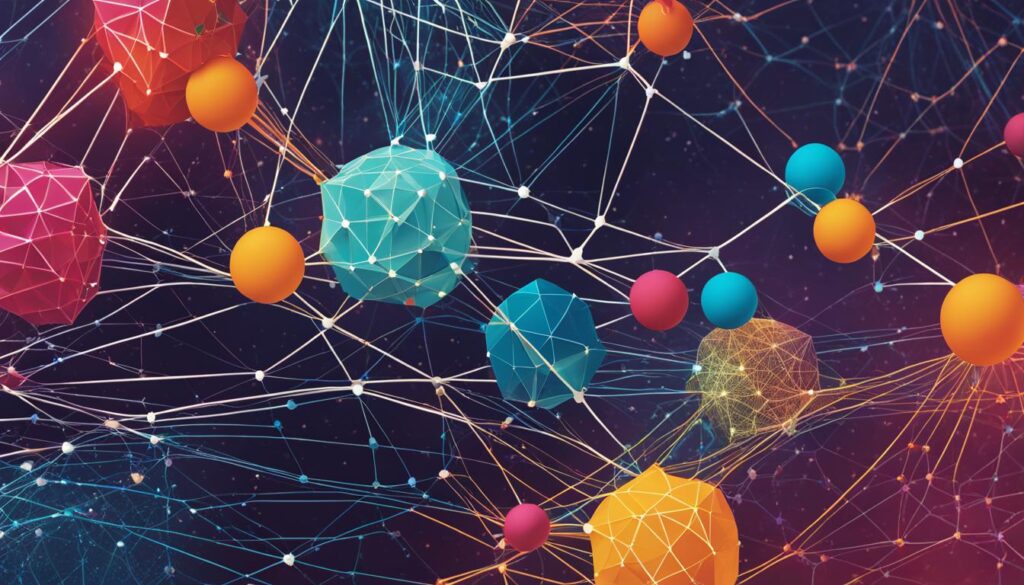Table of Contents
As the world continues to embrace artificial intelligence, deep learning is emerging as a driving force behind technological innovation. Deep learning is a subset of machine learning, an artificial intelligence technique that enables machines to learn by example.

What sets deep learning apart is its ability to identify complex patterns in data and make highly accurate predictions. This has led to remarkable breakthroughs in industries such as healthcare, finance, and transportation.
The deep learning market is expected to grow at a compound annual growth rate (CAGR) of 49.0% from 2020 to 2027. As this technology becomes more prevalent, it is important to understand its potential applications and limitations.
Recent deep learning trends point to increased adoption across industries. Companies are investing heavily in deep learning research and development, leading to new breakthroughs and advancements in the field.
In this article, we will explore the fundamentals of deep learning, its potential applications, recent advances, and future directions. We will also examine the ethical considerations and challenges associated with the widespread use of deep learning technology.
Key Takeaways:
- Deep learning is a subset of machine learning that identifies complex patterns in data.
- The deep learning market is expected to grow at a CAGR of 49.0% from 2020 to 2027.
- Recent trends show increased adoption of deep learning across industries.
- Understanding the potential applications and limitations of deep learning is important for its widespread adoption.
- Ethical considerations and challenges associated with deep learning must be taken into account.
Understanding Deep Learning
Deep learning is a subfield of machine learning that utilizes neural networks to train and improve AI models. Neural networks are modeled after the structure of the human brain, consisting of layers of interconnected nodes that process and analyze data.
Deep learning algorithms use these neural networks to learn and make predictions from complex data, such as images, speech, and text. The key advantage of deep learning technology is its ability to automatically learn features from raw data, without the need for manual feature engineering.
The deep learning technology that powers these systems is constantly evolving, with new algorithms and architectures being developed to improve performance. Some of the most popular deep learning algorithms include Convolutional Neural Networks (CNNs) for image recognition and Natural Language Processing (NLP) tasks, and Recurrent Neural Networks (RNNs) for text and speech analysis.
Why Deep Learning is important
Deep learning technology has become a critical component of many AI applications. Its ability to process and make sense of complex and large-scale data has made deep learning particularly useful in fields such as image and speech recognition, natural language processing, and robotics.
For example, deep learning algorithms are being used to develop self-driving cars, improve medical diagnosis and treatment, and identify fraudulent transactions in finance. The potential applications of deep learning are vast, making it a crucial area of research and development in the field of artificial intelligence.

“Deep learning is one of the most exciting areas of artificial intelligence research today. Its applications span many industries and have the potential to transform the way we live and work.”
Deep Learning Applications
Deep learning has vast applications across numerous industries, making it a highly versatile technology. As artificial intelligence continues to evolve, deep learning will play an increasingly important role in driving innovation and transformation.
Natural Language Processing
One area where deep learning has shown significant promise is natural language processing. Deep learning algorithms can be trained on large datasets of human language, allowing them to understand and generate natural language responses. This has numerous applications, including chatbots, virtual assistants, and language translation services.
For example, Google’s Neural Machine Translation system uses deep learning to improve language translation capabilities. This system has been shown to produce more accurate translations compared to traditional rule-based approaches.
Computer Vision
Another area where deep learning is making significant strides is in computer vision. Deep learning algorithms can analyze large amounts of visual data, enabling computers to recognize images and understand the contents of videos.
Self-driving cars are a prime example of deep learning applied to computer vision. These vehicles rely on deep learning algorithms to process data from sensors and cameras in real-time, enabling them to identify obstacles and adjust their driving accordingly.
Healthcare
The healthcare industry is also utilizing deep learning to improve diagnostics and treatment options. Deep learning algorithms can analyze medical images and patient data, helping doctors make more accurate diagnoses and develop personalized treatment plans.
For example, deep learning is being used to analyze mammography images to assist in the early detection of breast cancer. Similarly, deep learning algorithms are being developed to help identify early signs of Alzheimer’s disease.
“Deep learning algorithms can analyze medical images and patient data, helping doctors make more accurate diagnoses and develop personalized treatment plans.”
Overall, the applications of deep learning are vast and growing rapidly. From finance to transportation, deep learning is transforming numerous industries and paving the way for the future of artificial intelligence.
Recent Deep Learning Advances
Deep learning has seen several recent advances that have pushed the boundaries of what is possible. One of the most significant trends in deep learning is the emergence of new neural network architectures that enable more efficient processing of complex data.
One recent breakthrough in deep learning is the development of residual neural networks (ResNets). ResNets allow for the training of much deeper neural networks, which in turn can be used to tackle more complex problems. This approach has been used to improve performance in image and speech recognition tasks.
Another key advance in recent years has been the development of generative adversarial networks (GANs). GANs consist of two neural networks that are trained simultaneously: a generator network that creates new examples of data and a discriminator network that evaluates the authenticity of those examples. GANs have been used to generate photorealistic images, and they show promise for applications such as video synthesis and natural language processing.
New Neural Network Architectures
New neural network architectures have been a key driver of recent advances in deep learning. Convolutional neural networks (CNNs) have been used for image recognition tasks, while recurrent neural networks (RNNs) are often used for natural language processing and speech recognition.
Attention mechanisms are another recent development in deep learning. These mechanisms allow neural networks to focus on specific parts of input data that are most relevant for a given task. Attention mechanisms have improved the performance of neural machine translation systems and speech recognition tasks.
Machine Learning Techniques
Machine learning techniques have also contributed to recent advances in deep learning. Transfer learning, for example, allows neural networks to leverage knowledge gained from one task to perform better on a related task. Transfer learning has been used to improve performance in image recognition and natural language processing tasks.
Another machine learning technique that has contributed to advances in deep learning is reinforcement learning. Reinforcement learning involves training an agent to perform actions in an environment in order to maximize a reward signal. Reinforcement learning has been used for tasks such as game playing and robotics.

All of these recent advances in deep learning are driving innovation across a range of industries. In healthcare, for example, deep learning is being used to analyze medical images and develop new treatments. In finance, deep learning is being used for fraud detection and risk assessment. And in e-commerce, deep learning is being used to improve personalization and recommendation systems.
As researchers continue to explore new techniques and architectures, it is likely that we will continue to see rapid progress in the field of deep learning. These advances will enable more powerful and flexible artificial intelligence systems that can tackle some of the world’s most pressing problems.
Ethical Considerations in Deep Learning
The rise of artificial intelligence (AI) has sparked a great deal of excitement and debate in recent years. Deep learning, in particular, has emerged as a powerful technology with wide-ranging applications that have the potential to change the way we live and work. However, alongside the benefits come serious ethical concerns that must be addressed as deep learning technology becomes more widespread.
To begin with, deep learning algorithms are only as good as the data that they learn from. This means that if the data that an algorithm is trained on is biased or incomplete, the results produced by the algorithm will be biased or incomplete as well. For example, a facial recognition algorithm that is trained on predominantly white faces may struggle to correctly identify people of color.
“Bias can creep into the system in many ways, and it’s essential that we are mindful of these issues as we continue to develop deep learning technology.”
There are also privacy concerns associated with deep learning applications. For example, technologies that use facial recognition or other biometric data could be used for surveillance purposes, which would be a serious violation of privacy rights.
As deep learning technology evolves and becomes more sophisticated, there is a risk that it could be employed in ways that could be harmful to society. For example, some experts have warned that AI systems could be used to automate the production of deepfake videos or other forms of disinformation, which could have serious social and political consequences.
It is therefore crucial that we approach the development of deep learning technology with a critical eye and a strong commitment to ethical principles. The AI community must work together to develop standards and guidelines for the ethical use of deep learning, and to ensure that these technologies are used in ways that benefit society as a whole.
| Key Takeaways: |
|---|
| Deep learning algorithms are only as good as the data they learn from, which means that biased data can lead to biased results. |
| There are serious privacy concerns associated with deep learning applications, particularly those that use biometric data. |
| As deep learning technology becomes more sophisticated, there is a risk that it could be employed in ways that could be harmful to society, so it is important that we approach its development with a strong commitment to ethical principles. |

Challenges and Limitations of Deep Learning
While deep learning has shown tremendous promise as a subset of machine learning, it is not without its challenges and limitations. Here are some of the most significant ones:
- Training data limitations: Deep learning models are only as good as the data they are trained on. If the training data is limited or biased, it can affect the accuracy and performance of the model.
- Computational Power: Deep learning algorithms require massive amounts of computational power to function. This can make it difficult for smaller companies or research institutions to participate in the field.
- Interpretability: Despite its high accuracy, deep learning models are often considered “black boxes” because it’s challenging to understand how they arrive at their decisions. This can be problematic for certain applications like healthcare, where transparency is crucial.
- Overfitting: Deep learning models are prone to overfitting, which means they can memorize the training data instead of learning to generalize from it. This makes them less effective when given new, unseen data.
- Limited context awareness: Deep learning models lack true contextual awareness, meaning they can struggle to understand the nuances of human language, especially in situations like sarcasm, idioms, and double entendres.
Despite these challenges, researchers are actively working on ways to overcome them and improve the capabilities of deep learning.
Combining Deep Learning with Other Machine Learning Methods
While deep learning has many strengths, it’s not always the best solution for every problem. Often, combining deep learning with other machine learning methods can lead to more effective models.
For example, decision trees or random forests can be used to preprocess data before feeding it into a deep-learning neural network. This can reduce the likelihood of overfitting and improve model performance.
Similarly, reinforcement learning can be used to train deep learning models in dynamic environments where the optimal solution is unknown. Reinforcement learning can help the model learn from experience and improve its decision-making capabilities.
By combining different machine learning methods, researchers can create models that are more accurate, robust, and context-aware.
Future Directions in Deep Learning
As deep learning continues to push the boundaries of artificial intelligence, many researchers are exploring the future advancements of this technology. Here are some potential directions that may shape the future of deep learning:
- Hybrid approaches: As deep learning models become more complex, they may require the integration of multiple machine learning techniques to improve their accuracy and efficiency.
- Explainable AI: There is a growing need for deep learning algorithms to provide explanations for their decisions. This will improve their transparency and ethics, addressing concerns about bias and accountability.
- Semi-supervised learning: Deep learning models can benefit from both supervised and unsupervised learning. Semi-supervised learning combines both approaches to improve the model’s accuracy while requiring less labeled data.
- Federated learning: Federated learning allows multiple devices to train a shared deep learning model without sharing their data. This approach ensures privacy while still allowing the model to learn from a diverse range of data sources.
- Continual learning: Continual learning aims to enable deep learning models to learn continuously from new data without forgetting their previous knowledge. This approach will be critical for applications that require adaptation to evolving environments.
In conclusion, deep learning is set to transform the way we approach artificial intelligence in the years to come. With its potential to revolutionize various industries and drive innovation, it is no surprise that deep learning trends continue to grow. As researchers explore new directions and advancements, we can expect to see even more exciting developments from this cutting-edge technology.

Conclusion
In conclusion, deep learning is a rapidly evolving field that holds enormous promise for the future of artificial intelligence and machine learning. As we have seen, recent years have seen a surge in deep learning trends and advancements, making it one of the most exciting areas of research in AI.
Deep learning applications have transformed various industries, including natural language processing and computer vision, and continue to expand into new areas. Despite its potential, ethical considerations must be taken into account as the use of deep learning technology becomes more widespread. Issues such as algorithmic bias and privacy concerns need to be addressed to ensure the responsible application of advanced deep-learning techniques.
However, deep learning is not without its challenges and limitations. While it has demonstrated remarkable success in certain applications, there are still areas where it falls short. As such, it is important to consider complementary machine learning techniques to bolster deep learning approaches and improve their overall effectiveness.
The future directions of deep learning are undoubtedly exciting, with new advancements and applications on the horizon. With continued research and development, deep learning will undoubtedly continue to shape the landscape of artificial intelligence and machine learning.
Overall, as deep learning trends continue to progress, it is clear that this technology will play a crucial role in the future of AI and machine learning. The potential for innovative applications across various industries is enormous, and deep learning will certainly continue to be at the forefront of technological progress in the years to come.




